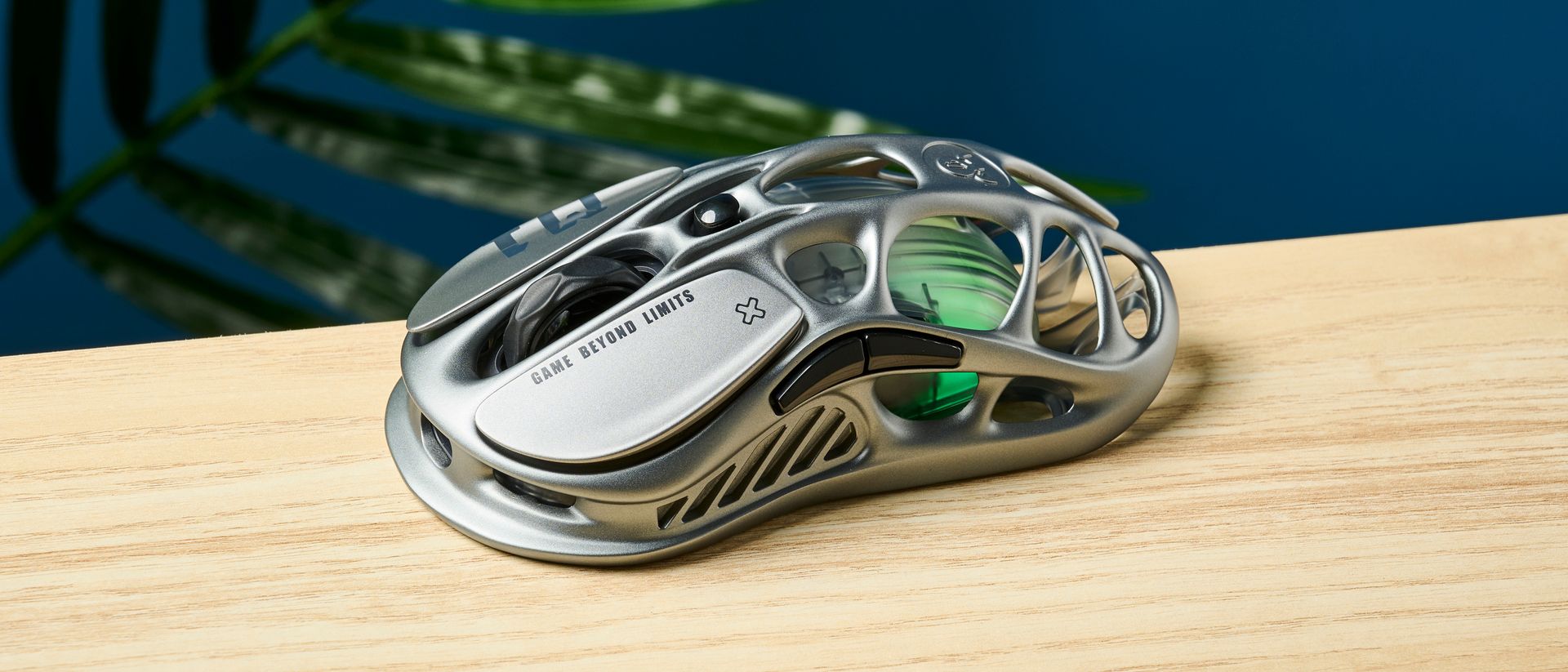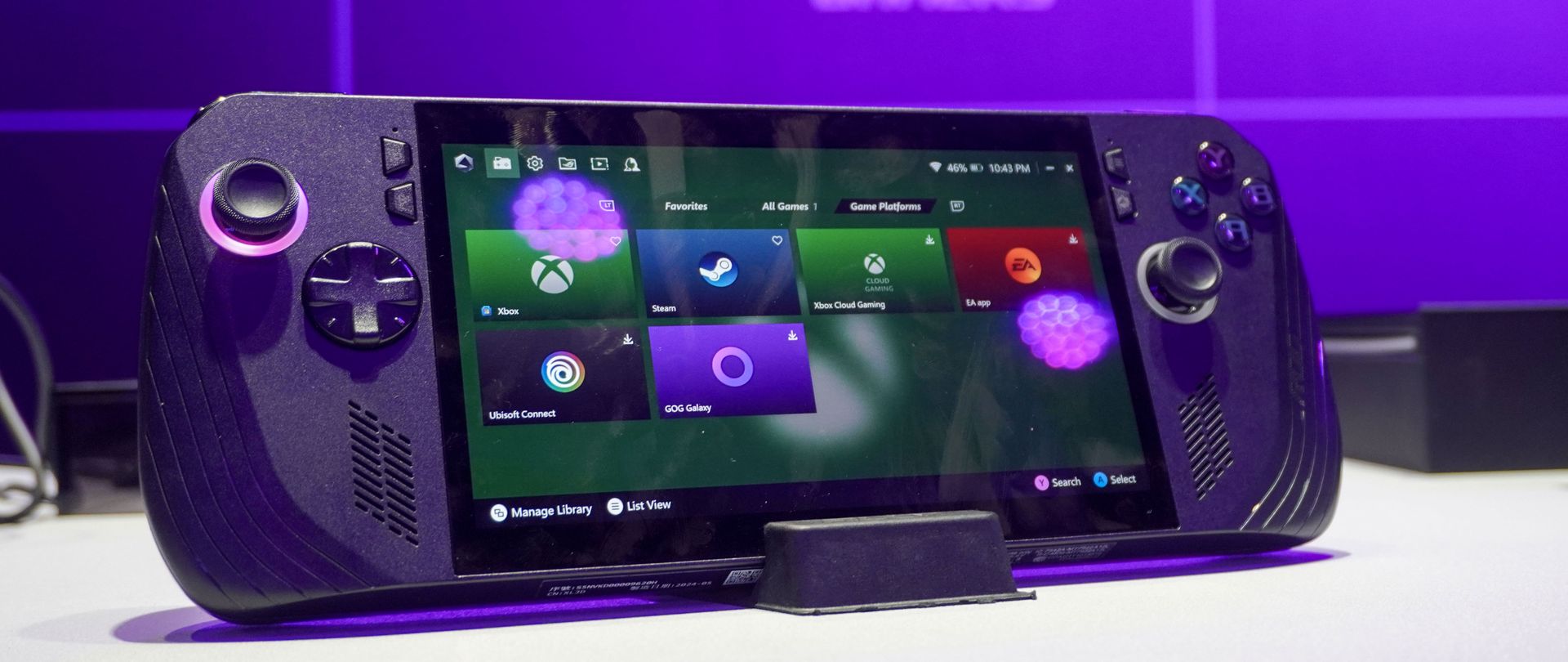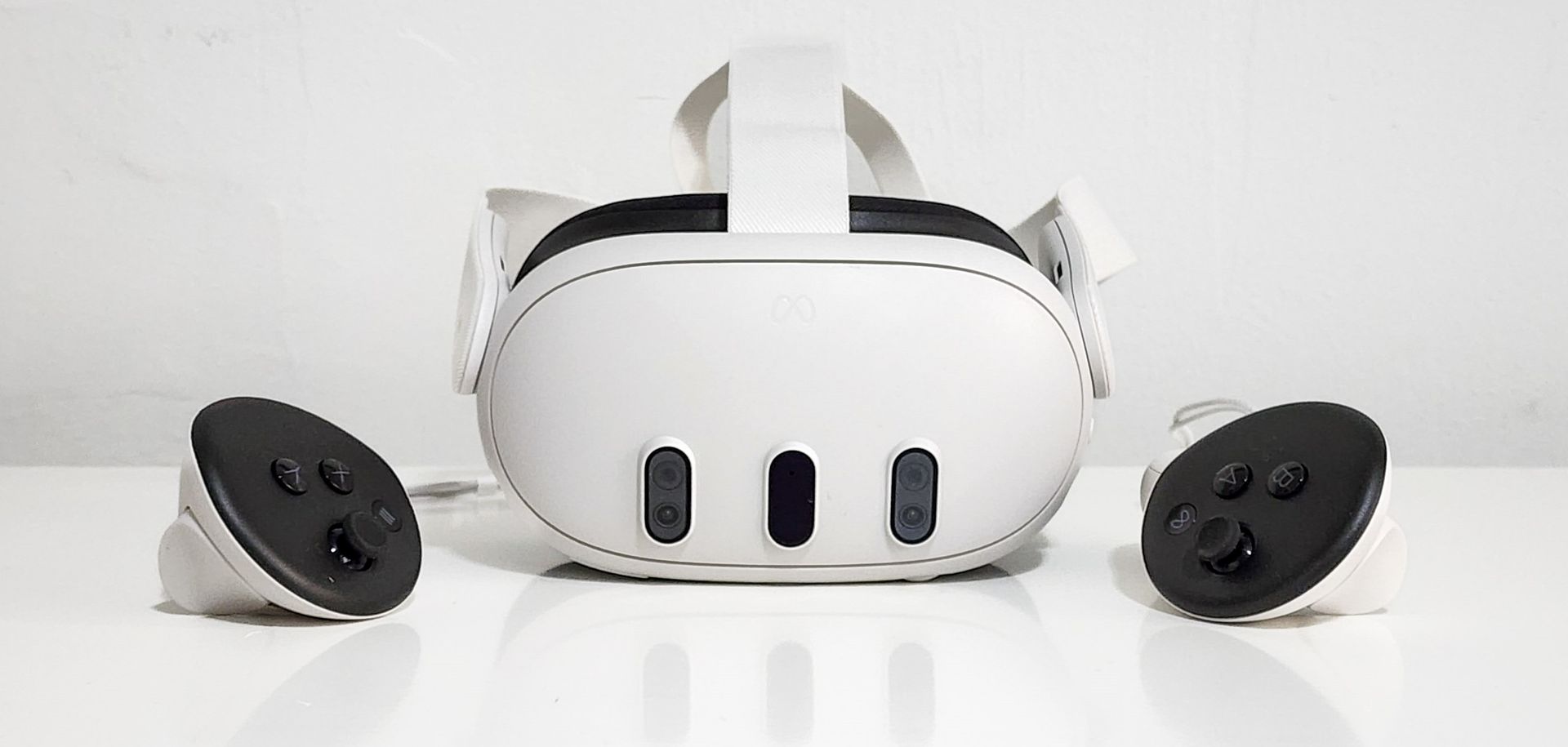Trade in Nintendo Switch
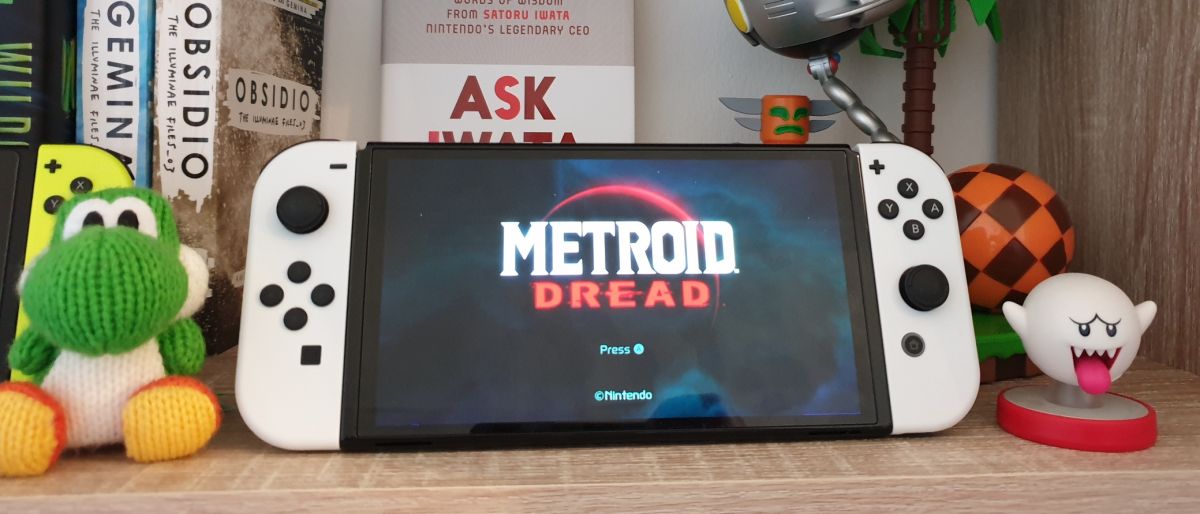
(Image credit: Future)
Nintendo Switch OLED two-minute review
The Nintendo Switch OLED makes a positive impression as soon as you turn it on. The gorgeous new 7-inch display immediately draws you in with its super-slim bezels, perfect blacks, and vivid colors – to the point where you’ll wonder how you ever made do with the original Switch’s lackluster LCD panel.
But it isn’t just the alluring OLED display that makes a strong first impression. The enhanced speakers, which are now hidden neatly underneath the console’s main attraction, are noticeably impressive. The Switch’s iconic ‘click’ has never sounded so crisp and clear, and we didn’t feel the immediate urge to reach for a pair of headphones when playing our favorite games.
We also enjoyed the console’s completely redesigned kickstand, which now spans the entire rear of the unit. It’s reminiscent of Microsoft’s excellent adjustable stands on its Surface line of devices, and it comfortably bests the original Switch’s flimsy little plastic stand, which could barely prop the console up. It’s a massive upgrade for tabletop mode users, and helps to elevate the console’s overall build quality in the process.
The 64GB of internal storage is another big tick in our book as you’re getting twice as much space as in the original Switch and Nintendo Switch Lite. However, it’s still a miserable amount compared to the likes of the PS5 and Xbox Series X, which offer far faster storage at significantly higher capacities. Thankfully, though, the console still comes with a microSD slot, so you can always add more if you need it.
So far, so good, then… but Nintendo has shamelessly overlooked one of the three core pillars of the Switch experience – TV mode – and the new console is a hard sell as a result. The company has seen fit to redesign the console’s dock, adding smoother edges, a LAN port for those who like to play online, and more breathing room for the console to rest inside comfortably. But you’re still capped to a 1080p output, as there’s no 4K upscaling, nor any other benefits for Switch players who prefer playing on their televisions. It means that whenever you dock the Nintendo Switch OLED, all of its main selling points are suddenly null and void, which kind of boggles the mind considering that this is a console that’s supposed to cater to three types of play equally well.
The lack of 4K output subsequently leads to a question that Nintendo will be unable to avoid when it comes to the Switch OLED: why are the internal specifications the same as the original Nintendo Switch and Nintendo Switch Lite? It feels entirely at odds with the console’s more premium feel when you load up the same sluggish Nintendo Switch eShop, or tired-looking games that could have used a bit more processing power to make them feel brand-new again. Countless titles and developers could have benefitted from a refresh of the Switch’s aging components, so it’s a shame Nintendo didn’t respond to the clamor from both developers and consumers with the console approaching its fifth anniversary.
So who is the Nintendo Switch OLED model for, and is it worth splashing the cash to upgrade if you already own the original Switch or handheld-only Switch Lite? Well, if you’re new to the Switch line, the answer is a definite ‘yes’ – this is the best version of Nintendo’s ingenious console to date, and one that corrects many of the faults of the original model. Those who have a Switch, and who primarily use it in handheld or tabletop mode could also find some value, thanks to the console’s gorgeous 7-inch OLED screen, excellent speakers, and redesigned kickstand. However, if you’re a current Switch owner who primarily uses your console in TV mode, we can confidently say that the Switch OLED would be a luxury and unnecessary upgrade.
If you’re new to Nintendo Switch, check our review of the original Switch modeland Nintendo Switch Lite. You can also watch our Nintendo Switch OLED video review below:
We are Tradelectronics, licensed second-hand electronics dealer located in Sydney CBD, experts in trading used laptops, old cameras & lens, and used mobile phones. Fast, Reliable & We Pay More! Get a free quote on your favourite WhatsApp, Facebook, SMS & Email, instant reply!
| Click icon for WhatsApp Quote | Click icon for facebook Quote |
 |
 |
- We are open from Mon – Sat 12pm – 7pm
- Get your free quote from WhatsApp and Messenger are highly recommended, we can guide you through in finding the accurate specs for your laptops, cameras & lens, mobile phones as well. As such we can provide a more precise quote for you.
NINTENDO SWITCH OLED DESIGN
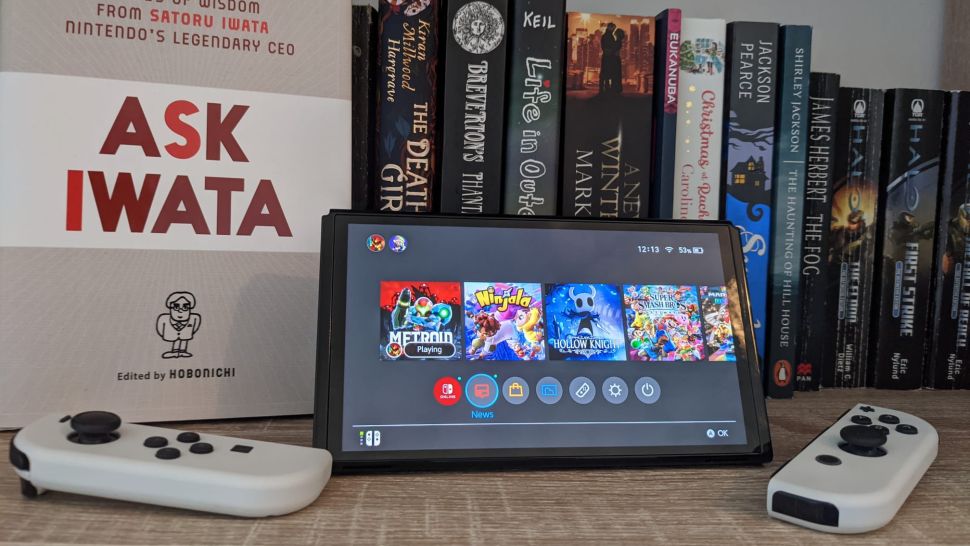
(Image credit: Future)
- Three modes: TV, handheld, and tabletop
- Same detachable Joy-Con controllers
- It comes with various accessories
If it weren’t for the larger screen and new pristine white Joy-Con controllers, you’d be hard pressed to notice any design differences between the Switch OLED and the original Switch. However, look a little closer, and there are several changes to be found.
The new 7-inch OLED display is the most prominent new design feature, and it’s surprisingly impactful, despite only being 0.8 inches larger than the original Switch’s 6.2-inch screen. As a result, the Switch OLED is slightly bigger than its predecessor: it’s 0.1 inches longer, at 9.5 x 0.55 x 4 inches (W x D x H), but it still feels immediately familiar in the hands.
The Switch OLED does have a bit more heft about it, though. It weighs 422 grams with the Joy-Con attached, which is about 22 grams more than the Nintendo Switch. We didn’t find that the added weight caused any fatigue when playing, thankfully, but it’s worth bearing in mind if you already feel like the Switch is a touch on the heavy side.
In the box you’ll find the same Nintendo Switch accessories that we’re used to seeing: two Joy-Con controllers, a pair of Joy-Con straps, and a Joy-Con Grip.
You also get the redesigned Nintendo Switch dock, which includes the new LAN port, and which is slightly longer but not quite as deep as the original dock. There’s a bit more wiggle room inside, too, which should allow for more efficient airflow, and lessens the chance that you’ll gradually scratch the Switch’s screen by repeatedly putting it in and taking it out of the dock. The dock itself is also a touch lighter, not that you’ll be moving it very often, and it contains one fewer 2.0 USB port.
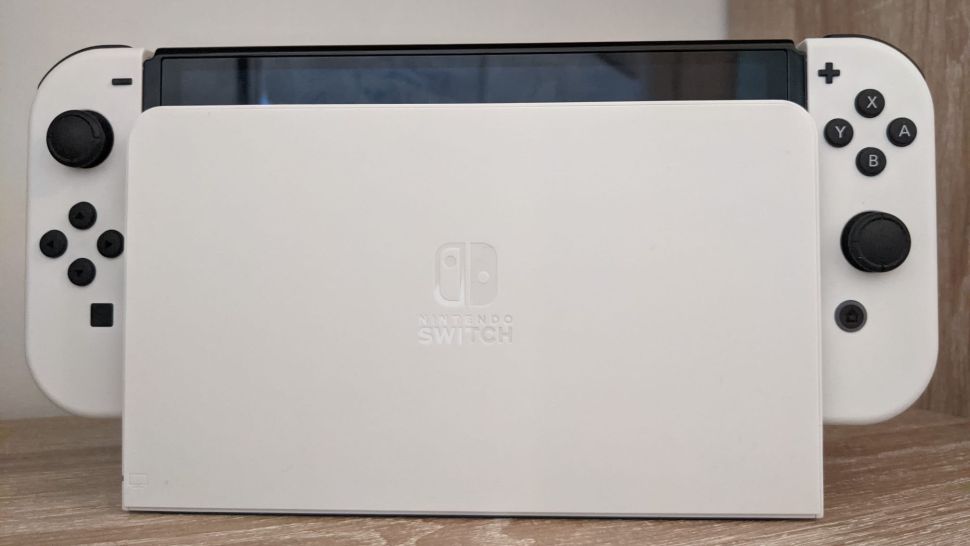
(Image credit: Future)
It’s also worth noting that the Nintendo Switch OLED will work in the old dock, and the original Nintendo Switch works in the new one – both may require a system update, but it’s pleasing to know that your old dock won’t be rendered entirely useless.
Other Switch OLED design changes include a repositioned microSD slot, which sits behind the wider kickstand and is easier to find, a slightly more recessed power button that’s now oval-shaped, and a wider volume rocker. The console also features smaller slits for the fans to exhaust hot air, which help to give the Switch OLED a more modern appearance. You also get a headphone jack, as on the other Switch models.
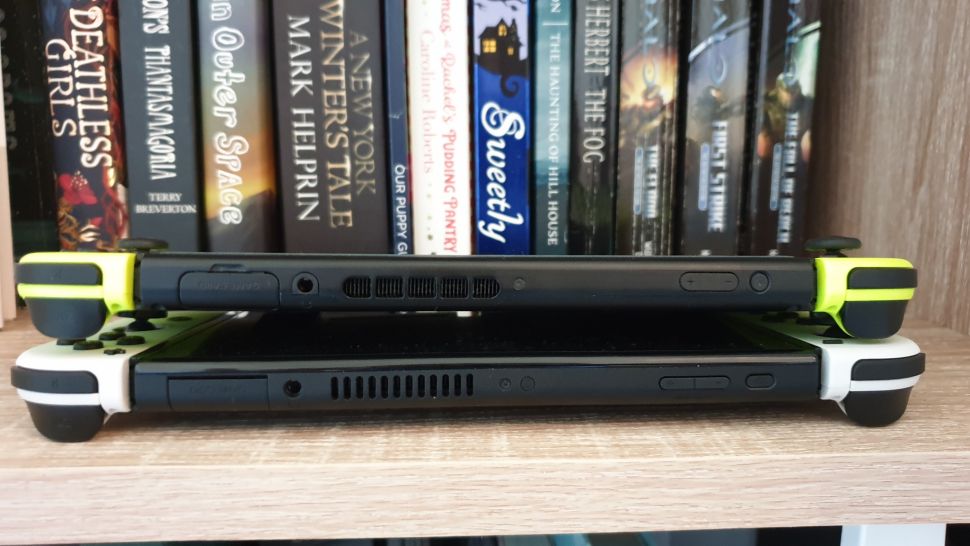
(Image credit: Future)
Aesthetically speaking, the Nintendo Switch OLED hides the older Switch’s product information and warnings. While it’s a small addition, the back of the Switch now looks much cleaner as a result, with the info tucked discreetly away behind the new stand.
While we mostly welcome the Nintendo Switch OLED’s more minor design touches, we severely dislike one change: the new Game Card slot. The little indentation present on the original Switch’s Game Card slot is now gone, making it almost impossible to open if you don’t have any fingernails. We found ourselves scratching at the Game Card’s new slot countless times in an attempt to pry it open, and frankly we can’t understand why this change was made when it’s objectively worse.
NINTENDO SWITCH OLED: HANDHELD MODE
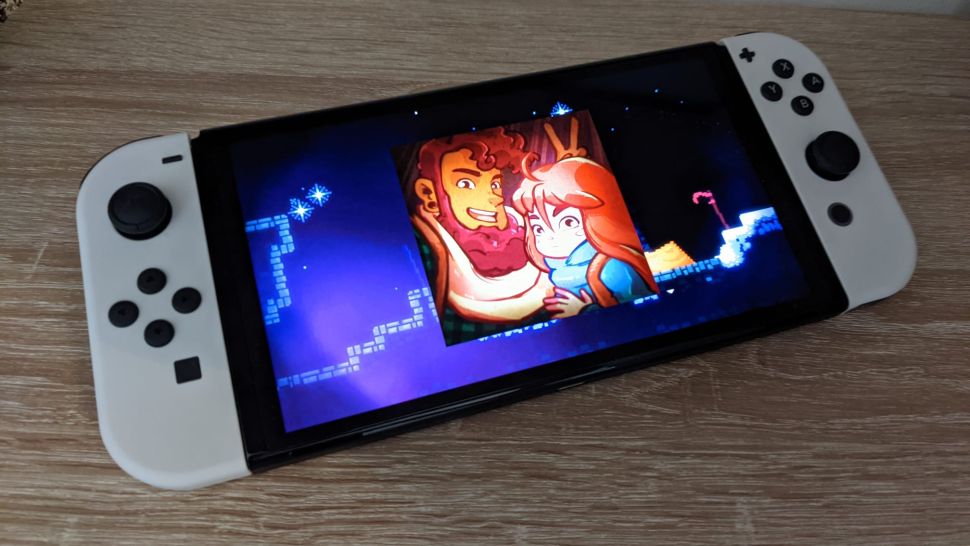
(Image credit: Future)
- The new 7-inch OLED display is a revelation
- Still not the most ergonomic design
- Joy-Con durability concerns remain
Nintendo’s Switch OLED model shines in handheld mode thanks to the console’s vibrant new display. The 7-inch OLED panel makes it easier to keep track of the action in fast-paced games like Super Smash Bros. Ultimate, and the high-contrast display also breathes new life into titles like Mario Kart 8 Deluxe. Metroid Dread is a great showcase for the display, as its dimly lit levels and alien-like color palette really benefit from the OLED’s incredible contrast ratio.
When compared side-by-side with the new display, the original Switch’s LCDpanel almost looks washed out in comparison. Everything looks punchy and enticing on the OLED model – blacks, in particular, are inky and inviting on the OLED, where on the original they look muted and gray.
The Switch OLED’s display is still only 720p; however, we found that games and text still looked sharp and legible when using the console in a comfortable playing position. We didn’t encounter any issues when it came to motion blur, either, and the display was suitably bright, even in daylight conditions.
We still don’t think the Nintendo Switch OLED is the most ergonomic gaming device we’ve ever used. The flat and wide shape of the console can lead to hand cramps during longer play sessions, and the Joy-Con controllers use the same design as the original console, which is now four years old, which means durability concerns remain. We found that the Joy-Con still has a tendency to move up and down ever so slightly when attached to the console, too, which we’ve always found rather concerning considering they’re supposed to lock in place.
NINTENDO SWITCH OLED: TV MODE
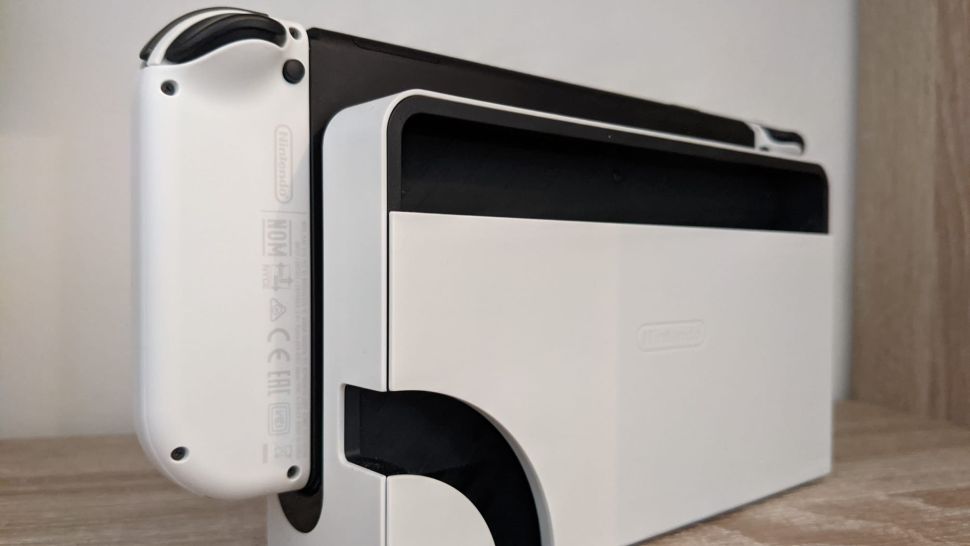
(Image credit: Future)
- No 4K support, still the same 1080p output
- No HDR support either
Unfortunately, the Nintendo Switch OLED offers absolutely zero improvements over its predecessor in TV mode. Yes, the new dock includes a LAN port for more stable online gaming compared to playing over Wi-Fi, but you still get the same 720p UI and a max output resolution of 1080p.
With 4K TVs now commonplace in most households, it seems like a massive oversight not to include any 4K support with the Switch OLED. Even the Xbox One S, a console released in 2016, is capable of outputting at 4K.
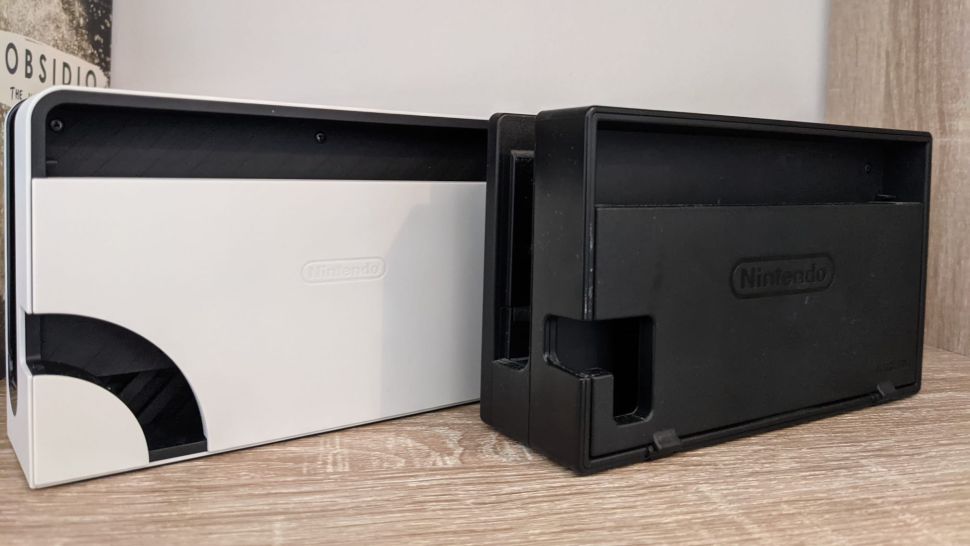
(Image credit: Future)
The Nintendo Switch OLED also doesn’t include support for high dynamic range, or HDR as it’s commonly known. Again, we’ve seen last-gen consoles like the PS4 and Xbox One offer this functionality for years now, so it would have been great to see Nintendo implement some modern-day display technologies to give TV mode a much-needed boost.
NINTENDO SWITCH OLED: TABLETOP MODE
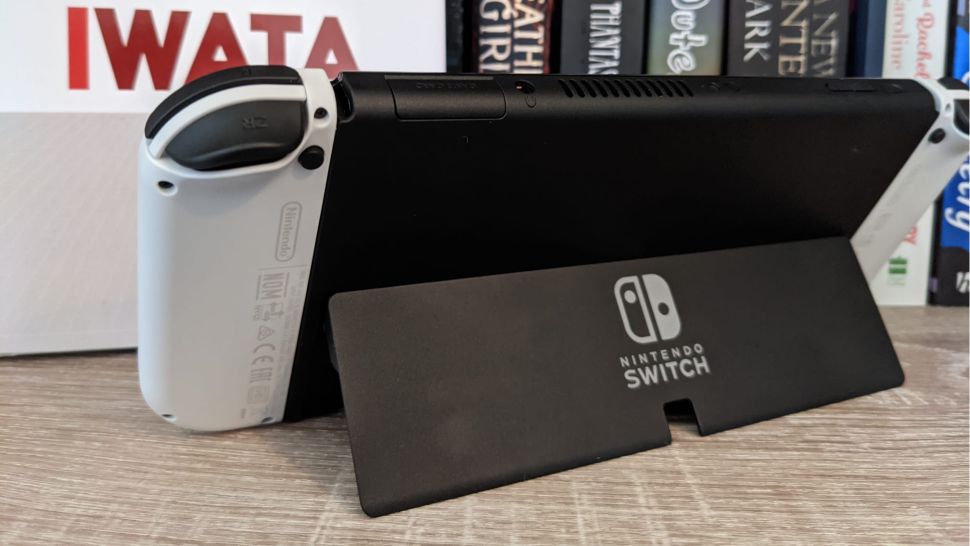
(Image credit: Future)
- Adjustable stand is a vast improvement over the original
- OLED display offers better viewing angles
- Enhanced speakers make a difference
Another plus point of the Nintendo Switch OLED is how it performs in tabletop mode. Thanks to its wider, redesigned kickstand, it’s now far easier (and safer) to use the Switch in tabletop mode, which is perfect for impromptu multiplayer sessions. The hinge is far more robust, and makes a satisfying thud when closed – we don’t have any concerns about it loosening over time and failing to snap into place like the old kickstand did.
As on the original Switch, Joy-Con controllers can be detached from the side of the unit, allowing you to prop the console on a table or other surface to play with a friend (or stranger) at a moment’s notice. But where the old kickstand limited you to one viewing angle, the Switch OLED’s adjustable stand can be positioned in multiple ways. It makes for a far more enjoyable viewing experience, and the excellent viewing angles of the OLED display mean you don’t need to huddle together so tightly when facing off in Mario Kart 8 Deluxe.
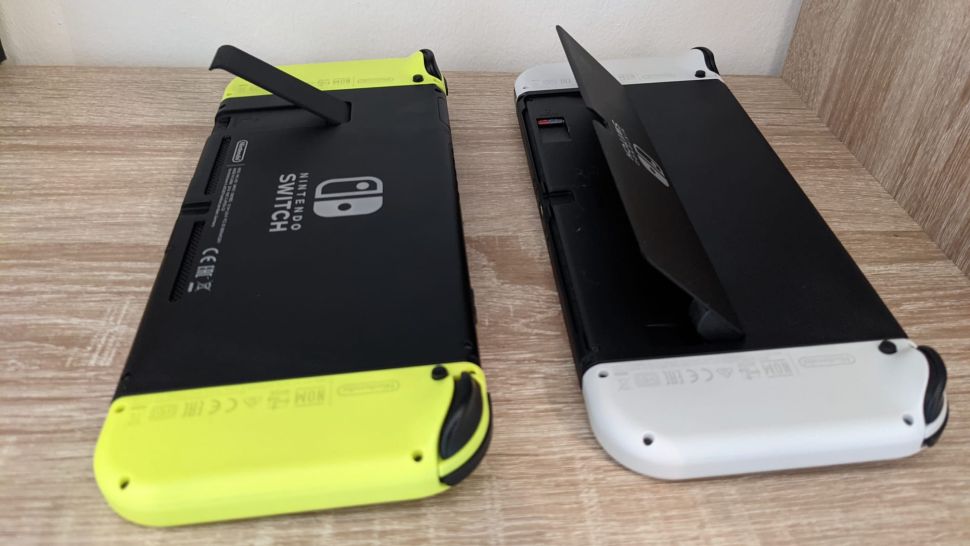
(Image credit: Future)
The Nintendo Switch OLED’s enhanced speakers also really come to life in tabletop mode. We found that our favorite games sounded punchy and clear, without any distortion at higher volumes, which is essential when you can’t reach for a pair of headphones.
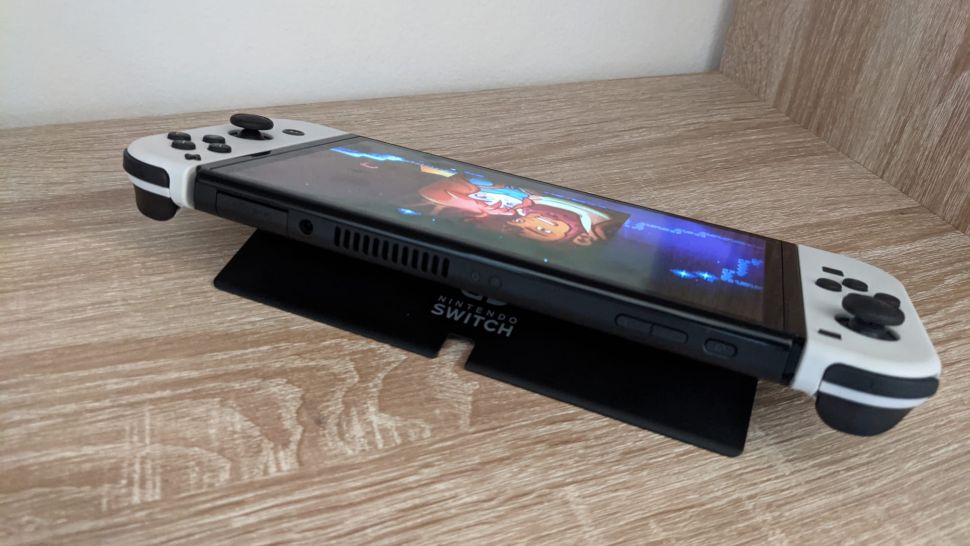
(Image credit: Future)
NINTENDO SWITCH OLED PERFORMANCE
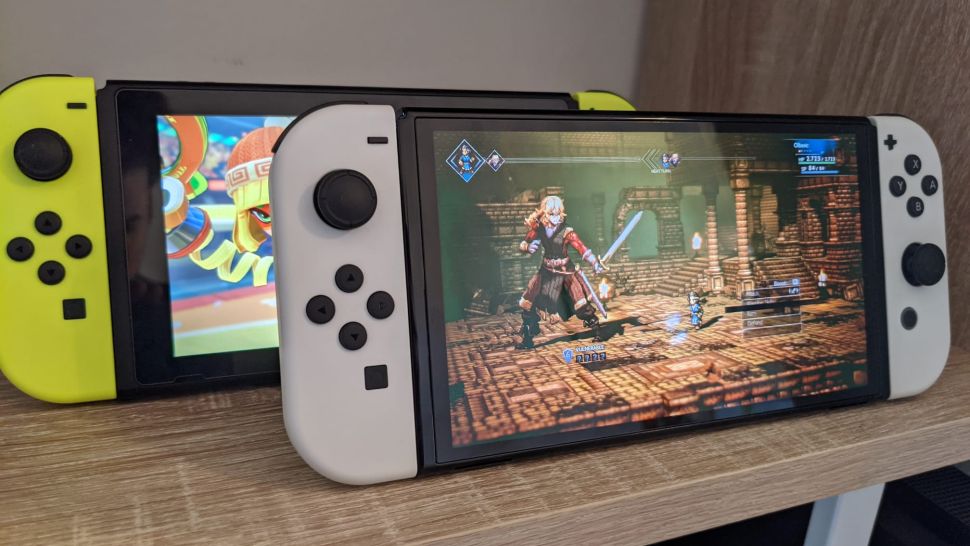
(Image credit: Future)
- Exactly the same tech specs as the original Switch
Even though the original Nintendo Switch is approaching its fifth anniversary, the Nintendo Switch OLED model offers no performance boost whatsoever. The enhanced display aside, the best Switch games look and play the same as before, with the new console having the same Nvidia Custom Tegra X1 processor and 4GB of RAM as its predecessor, which will come as a disappointment to those who were hoping for a more powerful Switch model.
Most Switch games still play perfectly well, of course, but there’s no doubt that the console’s hardware is beginning to show its age, especially now that the PS5 and Xbox Series X are on the market.
Games will at least look prettier thanks to the console’s new high contrast display, and for some, that might be enough – but we were hoping for more here. Thankfully, battery life is on par with the Nintendo Switch (2019) version, so expect between 4.5 hours and nine hours, depending on the game you’re playing.
NINTENDO SWITCH OLED GAME LIBRARY
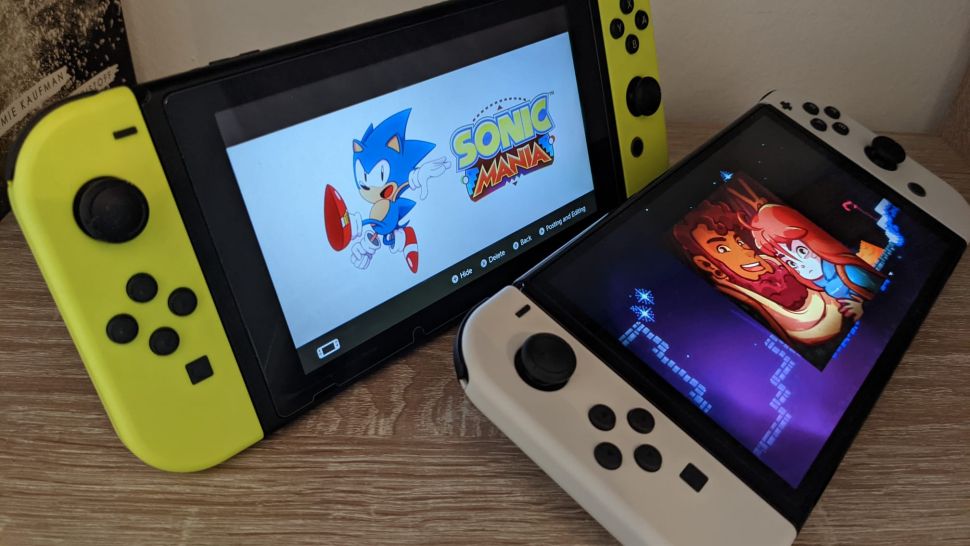
(Image credit: Future)
- Exceptional library of titles to choose from
- More big releases are on the way
Of course, the main reason to pick up a Nintendo Switch OLED is to play games, not just to ogle the new hardware. And it’s here where the Switch excels.
The Switch’s library of games is jam-packed with some genuinely timeless classics, like The Legend of Zelda: Breath of the Wild, Super Mario Odyssey, Mario Kart 8 Deluxe, Animal Crossing: New Horizons, and Super Smash Bros. Ultimate.
And it’s not just Nintendo’s first-party lineup that makes the Switch an appealing prospect; the console is also home to fantastic indie games such as Hades, Celeste, and Spelunky 2, many of which feel far more enjoyable to play untethered from the TV.
It means there’s a game to suit practically every player’s tastes, and there are many more blockbusters titles to come, including Breath of the Wild 2, Pokémon Legends: Arceus, and Splatoon 3. You’ll have plenty of titles to play on the Nintendo Switch OLED, then.
SHOULD YOU BUY THE NINTENDO SWITCH OLED?
Buy it if…
You play almost exclusively in handheld and tabletop mode
The Nintendo Switch OLED’s most significant improvements come to the fore when you’re playing in handheld or tabletop mode, with the gorgeous OLED screen, wider kickstand, and enhanced speakers combining to offer a far more enjoyable experience.
You’re a first-time Switch buyer
With its new display, improved kickstand, and enhanced speakers, this is the best version of the Nintendo Switch to date. If you’re a first-time buyer, it’s easy to recommend it over the original model, despite the higher price tag.
Don’t buy it if…
You primarily play Switch games in TV mode
Almost all of the console’s new benefits disappear once the Nintendo Switch OLED is in its dock. The console still outputs at 1080p, which can look noticeably soft on 4K displays, and there’s no HDR, VRR, or auto low-latency mode support.
You want a more powerful Switch
The internal storage boost aside, the Switch OLED has the exact same technical specs as the original model, so you won’t experience any improvements to resolution or frame rates over the original Switch when playing games.
FAQS
What is an OLED display?
Is the Nintendo Switch OLED prone to burn-in?
But could the Nintendo Switch OLED be susceptible to burn-in? Nintendo told TechRadar: “We’ve designed the OLED screen to aim for longevity as much as possible, but OLED displays can experience image retention if subjected to static visuals over a long period of time.
“However, users can take preventative measures to preserve the screen by utilizing some of the Nintendo Switch console’s included features, such as using auto-brightness to prevent the screen from getting too bright, and enabling the auto-sleep function to put the console into “auto sleep” and turn off the screen after short periods of time.”
Source: Techradar

